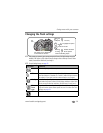
37 www.kodak.com/go/support
Doing more with your camera
PASM and C1, C2, C3 modes
Settings you change in C modes apply only to pictures taken in those modes.
For example, if you change the Color Mode to Sepia while in PASM, you still retain the
color setting if you change to Auto or SCN mode. If you are in the C modes, the color
change is applied to pictures taken only in those modes.
NOTE: The settings, including Flash, are maintained for PASM—even when you change modes or turn off
the camera. Use Reset Camera (see page 48) to reset PASM to their default settings.
Aperture—also known as f-stop or f-number,
controls the size of the lens opening, which
determines the depth of field. Smaller f-numbers,
for example f/2.8, refer to a bigger lens opening.
Larger f-numbers, for example f/8, refer to a smaller
lens opening.
Larger f-numbers keep the main subject sharp;
good for landscapes and well-lit conditions. Smaller
f-numbers are good for portraits and low-light
conditions. The highest and lowest aperture
numbers may be affected by optical zoom.
Shutter Speed—controls how long the shutter stays open. A shaking hand icon
warns of slow shutter speeds. (Use a tripod for slow shutter speeds.)
Exposure Compensation—lets you manually adjust the exposure (+/- 2.0 in
1/3 steps); good for controlling backlit or non-standard scenes. If the picture is too
light, decrease the setting; if it’s too dark, increase the setting.
Flash Compensation—controls the flash brightness ±1.0 in 1/3 EV steps. You
must be within flash range. Unavailable if flash setting is Off.
ISO—controls sensitivity of the camera sensor. Higher settings are more sensitive
to light, but may produce unwanted “noise” in a picture. You can use ISO 800 only
when you are in the 1.2 MP Picture Size setting (see page 43).
Aperture
Shutter
Exposure
ISO
Compensation
Flash
Compensation
Speed


















